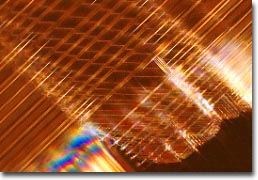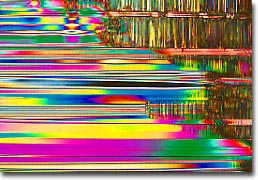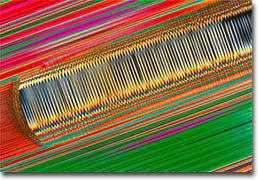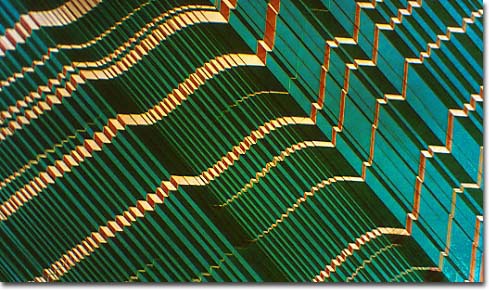|
Perovskites are a large family of crystalline ceramics that derive their name from a specific mineral known as perovskite (CaTiO3) due to their crystalline structure. The mineral perovskite, which was first described in the 1830s by the geologist Gustav Rose, who named it after the famous Russian mineralogist Count Lev Aleksevich von Perovski, typically exhibits a crystal lattice that appears cubic, though it is actually orthorhombic in symmetry due to a slight distortion of the structure. Members of the class of ceramics dubbed perovskites all exhibit a structure that is similar to the mineral of the same name. The characteristic chemical formula of a perovskite ceramic is ABO3, with the A atom exhibiting a +2 charge and the B atom exhibiting a +4 charge. The atoms of the unusual material are generally arranged so that 12 coordinated A atoms mark the corners of a cube, octahedral O ions are featured on the faces of that cube, and tetrahedral B ions are located in the center of the structure.

Lanthanum Aluminate High Magnification
Experimentation with minerals and pressure in the 1970s resulted in the discovery that many substances transform into a dense, perovskite structure when exposed to high levels of pressure. As Lin-gun Liu of the Australian National University demonstrated, for instance, the common mineral enstatite (MgSiO3) can be used to synthesize a silicate perovskite. This same transformative capability is possessed by a great number of the minerals believed to comprise the Earth's interior. Thus, as Liu posited, perovskites are likely extremely copious within the lower mantle, where high pressure affects the lattice structures of other minerals. Based upon this likelihood, Liu also suggested that silicate perovskite is the most abundant mineral on Earth, estimating that it comprises about half of the planet's bulk. Due to such a possibility, perovskites have been of continuing interest to geologists for the clues they may hold regarding the planet's history.

Lanthanum Aluminate Low Magnification
Although typically the perovskite crystalline lattice is cubic, in some instances changes may be induced in the structure. For example, the central Ti cation of barium titanate (BaTiO3) can be stimulated to shift to an off-center position, resulting in a symmetry that is not cubic as well as an electrostatic dipole, in which the positive and negative charges align toward opposing ends of the structure. The existence of this dipole is accountable for the ferroelectric attributes exhibited by barium titanate. This compound as well as other familiar perovskites, such as CaTiO3 and SrTiO3, may achieve impressive dielectric constants, which makes them well suited for use in capacitors, components in electric circuits that temporarily store energy. The capacity of these devices can be greatly increased through the inclusion of a solid dielectric material. Due to the fact that some ceramics are readily transformed into extremely effective dielectrics, it is estimated than more than 90 percent of all capacitors produced contain ceramics, such as perovskites.

Lanthanum Aluminate-Y123 Thin Film
Superconductivity, a phenomenon characterized by the disappearance of electrical resistance in various metals, alloys, and compounds when they are cooled to very low temperatures, was first observed in 1911 by Heike Kamerlingh Onnes. In Onnes' early studies, he noted that the resistance of a frozen mercury rod abruptly dropped to zero when cooled to the boiling point of helium, 4.2 Kelvin. He also discovered that a material in a superconducting state can be returned to its standard, nonsuperconducting condition through exposure to a strong magnetic field of a certain critical value or by passing a large current through it. Though such findings were considered important, and Onnes was even awarded the Nobel Prize for Physics in 1913, the extremely cold temperatures required to instigate superconductivity necessitated the use of liquid helium, which made it cost prohibitive to utilize traditional superconductors for many applications. The discovery of perovskite superconductors revolutionized this field, however, and by 1987, superconductivity in these materials could be induced above 77K, the boiling point of liquid nitrogen. This significant advance made superconductors cheaper to cool to their critical temperature, since liquid nitrogen is considerably less costly than liquid helium.

Lanthanum Aluminate High Magnification Twinning
The first superconducting perovskite was discovered by IBM researchers Bednorz and Mueller, who were examining the electrical properties of a family of materials in the Ba-La-Cu-O system. One of the materials they were studying was reported to have a critical temperature of approximately 35 Kelvin, which was a benchmark in field of superconductivity at the time. For their discovery, which opened up an entirely new area of study since their high-temperature superconductors did not conform to the BCS theory widely believed to govern the activity of all superconductors known up to that time, Bednorz and Mueller were awarded the Nobel Prize for Physics in 1987. Meanwhile, between 1986 and 1988 the critical temperature for superconductivity in perovskite ceramics was raised by more than 100 Kelvin, but in recent years only several degrees have been added to this remarkable elevation. Many of these minor increases in the critical temperatures of ceramic superconductors have stemmed from the utilization of increasingly exotic elements in the base perovskite.

Lanthanum Aluminate Twinning
Though research continues to be fast and furious in the field, and while investigators are still synthesizing new ceramic perovskites, they are also directing their attention to practical applications for the ceramics that already exist. Indeed, in addition to capacitors, some perovskites have begun to find wide use in piezoelectric devices, which generate electricity when they are subjected to mechanical pressure and, conversely, undergo a change in dimension when exposed to an applied voltage. Piezoelectric perovskites obtain their distinctive properties through processes that cause their typically cubic structures to shift so that they lack a true center of symmetry, as discussed above in regard to barium titanate. The ceramics synthesized to be piezoelectric may be used in a wide variety of products, including communications equipment, crystal-controlled timing devices, transducers, pressure gauges, buzzers, and accelerometers. Interestingly, perovskites have also been found to show significant potential for use as materials that may safely encapsulate radioactive waste and are being heavily investigated by scientists in the environmental discipline for such purposes.
|





